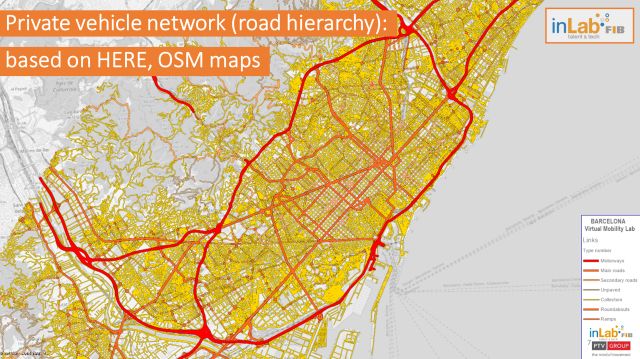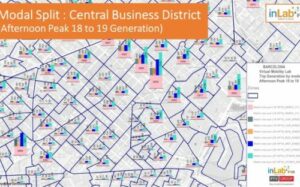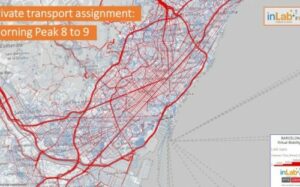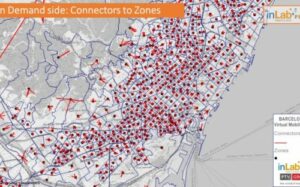Barcelona Virtual Mobility Lab for Carnet
- SEAT
- KINEO
- VOLKSWAGEN
- PTV GROUP
- GRASS GIS, Matlab, Plataforma VISUM, Python, R, Slack, SQLServer
Home » Success Stories »
Description
The inLab FIB UPC has carried out the first detailed multimodal modeling of the Primera Corona of the Metropolitan Area of Barcelona that integrates both the supply of all modes of public transport, as well as the road for private vehicles and the demand for updated mobility. The new modeling will support, once the model has been validated and calibrated, both decision-makers in mobility policies, as well as transport operators or new companies that develop new mobility alternatives and want to evaluate them.
The Primera Corona consists of 18 municipalities and has been divided into around 630 transport zones (TAZ, Transport Analysis Zones) compatible with the hierarchy of administrative division (counties, municipalities, districts, census sections). The zoning criteria have been: homogeneity of size in terms of population (around 5000 people/TAZ) and homogeneity of land uses and access to infrastructure. Transport hubs have been specifically considered (Airport, for example). The city of Barcelona has been divided into around 350 TAZs.
The development of a fully multimodal model has been made possible by the detailed representation of the modal interchanges.
The demand for mobility between pairs of transport zones (OD pairs) has considered data from mobile telephony (KINEO) from the end of March 2017, therefore very current. A first version of modal mobility matrices for the study area has been obtained by merging with historical data published by the area’s transport authorities. The validation of the modal demand obtained reflects the known and published data.
VML is being developed as part of the CARNET initiative and in collaboration with SEAT and PTV IBERIA.
Articles and presentations
- Modelitzant la mobilitat urbana, Blog CIT-UPC, 9 abril 2018
- inLab FIB a les IX jornades sobre ITS a Catalunya, Notícies inLab, 8 febrer 2018
- El Virtual Mobility Lab rep el Premi ITS en Trànsit Urbà, Notícies inLab, 24 abril 2018
- Novetats i tendències en l’anàlisi de dades geolocalitzats per a l’estudi del transport i la mobilitat, Kineo talks, 23 maig 2018





